The paper deals with the theme of reading-based lessons and their effective conduct. Being able to effectively read and analyze texts when learning English as a second language is one of the most important parts of constructing one’s knowledge of English. Reading fictional short stories is beneficial not only for broadening students’ vocabulary, but also for their creativity — analyzing characters and plot from various angles of any composition is a solid way of exercising one’s flexible thinking. However, it may be difficult to organize lessons which are primarily focused on reading short stories, as it requires a certain level of attention from students — being able to concentrate on a wholly textual composition, understand and analyze it. Nowadays, the problem is becoming even more critical as modern students struggle with their attention span. That is why as a teacher, it may be complicated to plan out and conduct this type of lessons. However, the utilization of certain techniques and tasks which allow for one’s creative thinking may lead to the productive conduct of classes focusing on reading long texts. Our current generation is getting used to the convenient absorption of information in fragments and is slowly losing the ability to concentrate on big textual pieces. Keeping it in mind, it is still possible to compose effective lessons while ensuring that students retain their focus on the content of short stories and are occupied in the reading activities. The paper describes the research conducted and ways of productive reading of short stories and provides examples of activities which may be utilized on this type of lessons.
Keywords: reading-based lessons, reading, reading comprehension, teaching, TESOL.
Introduction
Reading is the most important skill in second language acquisition [1]. Reading specifically fictional short stories is useful for undergraduate students in terms of developing their lexical knowledge, improving their understanding of various cultural and social backgrounds of different times through the lens of a fictional composition, as well as developing their empathy when absorbing a text describing multiple characters’ actions, thoughts and feelings. In many ways, it is a beneficial activity for anyone aiming to enhance their knowledge of the English language as the second one. However, as it was mentioned above, conducting reading-based lessons may have its own difficulties, specific for this type of classes.
Methods
The method utilized was survey. First, we conducted a survey for 11 teachers to determine their views on various aspects of reading-based lessons. Further, we constructed a survey for 11 students to examine the type of tasks they would prefer for lessons focused on reading.
Results
Receiving the results, it was seen that 63.64 % consider the decreasing attention span of students to be the most difficult part in conducting lessons, focused on reading, as lower attention span leads to non-productive reading, 18.18 % think that evoking students’ interest in finding literary works’ message and morale is the most complicated part and another 18.18 % consider inciting students’ produce of viewpoints on characters’ and events of a story to be the most arduous.
Table 1
Questions from the survey for teachers
|
What do you consider to be the most difficult part in conducting reading-based lessons? |
What types of tasks do you think are the most interesting for students to do when analyzing a story? |
What do you think students enjoy the most when working with literary works? |
Further, 81.82 % shared that they consider creative tasks to be the most compelling for students to do when analyzing a story, while 18.18 % consider exercises prompting students to share their opinions, but not exactly demanding much creativity to be the most absorbing for them in the classroom. Then, 54.55 % think that analyzing characters’ inner world is the part students enjoy the most when working with literary works, 36.36 % consider that analyzing plot events is the part students find the most compelling during this type of lessons, while 9.09 % shared that they think that defining a story’s morale and message is the part students find to be the most absorbing for them when working on with fictional stories.
Table 2
The teacher’s survey results
|
Answers for Question 1 |
Answers for Question 2 |
Answers for Question 3 |
|
Decreasing attention span of students — 63.63 % |
Creative tasks — 81.82 % |
Analyzing characters’ inner world — 54.55 % |
|
Evoking students’ interest in finding literary works’ message and morale — 18.18 % |
Exercises prompting students to share their opinions, but not exactly demanding much creativity — 18.18 % |
Analyzing plot events — 36.36 % |
|
Inciting students’ produce of viewpoints on characters’ and events of a story — 18.18 % |
Defining a story’s morale and message — 9.09 % |
Next, we conducted the survey for students. We utilized two of the questions which were used for the teachers’ survey — one on the preferred type of tasks and one on the most compelling part for them during this type of lessons.
Table 3
Questions from the survey for students
|
What types of tasks do find to be the most interesting when analyzing a story? |
What do you enjoy the most when working with literary works? |
For the first question, 72.73 % of the students consider creative tasks to be the most interesting for them to work on when analyzing a story and 27.27 % think that exercises prompting them to voice their viewpoints, but which do not require much creativity are the most compelling for them. One can see that teachers voted correctly, when they considered creative exercises to be the most absorbing for students to work on during story analyses, which resulted in the course which was chosen for composing examples of tasks a teacher could make use of on the reading-based lessons, described in the paper. When it comes to the second question, 63.64 % shared that they find analysis of characters’ inner world to be the most interesting part of this type of lessons, 18.18 % answered that they find plot events’ analysis to be the most engaging part of lessons focused on reading and another 18.18 % consider defining a literary work’s morale and message to be the most compelling part of reading-based lessons for them.
Table 4
|
Answers for Question 1 |
Answers for Question 2 |
|
Creative tasks — 72.73 % |
Analyzing characters’ inner world — 63.64 % |
|
Exercises prompting students to share their opinions, but not exactly demanding much creativity — 27.27 % |
Analyzing plot events — 18.18 % |
|
Defining a story’s morale and message — 18.18 % |
Once again, teachers’ and students’ viewpoints synchronized — the majority of both teachers and students consider character analysis as the most absorbing part of lessons focused on working with fictional stories. As a result, that also determined the course chosen for the composition of exercises presented in the paper — there is a preponderance of tasks which we presented specifically for character comprehension.
Discussion
As one can see from our research results, the most prevalent issue teachers are facing nowadays is the decreasing attention span of students, which is the result of a constant consumption of information in rather small parts on the Internet, whether it be a textual or a video-material. Needless to say, it affects reading-based classes as they deal with studying and analyzing extensive texts.
Warm-up activities are a significant part of any lesson, however they possess a special usefulness when it comes to lessons primarily focused on reading. To prepare students for reading a lengthy material, conducting a warm-up exercise combining English with some entertaining activity is a good way to stimulate their attention and energize them before the reading work. This way the students would revive their attention levels and be more prepared for absorbing extensive textual material. For instance, the teacher could conduct a short karaoke-imitating activity with the use of the students’ favourite songs in English or a brief game where each of them throws a ball to each other and asks each other various questions.
When it comes to the actual reading part, it is more effective for students to read short stories in fragments, rather than as a whole composition in one sitting. The reason for that would be that as we mentioned above, nowadays it became more difficult for people to concentrate their attention on extensive textual information. We suggest dividing the short story which the teacher is planning to utilize in the reading class into several parts in advance, next composing short reading comprehension tasks or simple questions for each of the fragment of the text. As a result, students would read the parts of the text one by one, while also simultaneously working on the tasks based on the fragments they have just read — this technique allows them to have an engaging reading, rather than a passive one, as they need to read the material attentively to be able to do the short tasks.
Another way to conduct effective reading would be to separate a short story into different parts, divide students into small teams and provide each of the groups with one of the fragments without repetition, handing them out in a form of a part of a puzzle, after which they would have to analyze their fragment of the text, explain their part each in turn to the rest of the students and conjointly decide on the correct sequence of the story. Then, they would have to connect the parts of a puzzle in accordance with their judgement. This exercise is a form of the «jigsaw» technique, which is a type of cooperative learning and actively encourages students to help each other in the mastery of a subject matter to get maximum achievement [2]. An activity of such type promotes teamwork, the ability to explain the material having been read verbally, as well as their skill of making correct assumptions. Furthermore, connecting pieces of a puzzle makes for a slight game element. One can make use of various printable illustrations of a puzzle and add parts of the story there to utilize the puzzle fragments on the lesson.
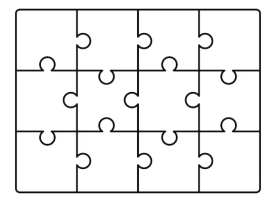
Fig. 1. An example of a puzzle
Jiggsaw reading is useful for an effective absorption of the textual information as collaborative work occupies each student in the activity.
Using creative exercises when working on understanding and analyzing the text is a solid way to incite students’ engrossment. Defining characters’ notable styles of behavior, their personality traits may be done through the utilization of tasks demanding flexible imagination. For instance, the teacher could conduct the task which asks students to divide into small teams and to pretend that the story is set in a modern setting and the primary characters have their own group chat, further mentioning that one of the characters left the conversation in a messenger and they have to compose the «text bubbles» from each characters, constructing a dialogue which led to one of them leaving the chat.
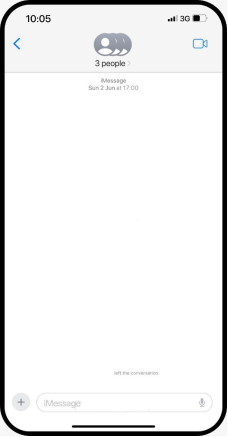
Fig. 2. «Group Chat» task
This task is good for determining the level of the students’ understanding of characters of a story, as to create the «chat history» they need to produce a realistic dialogue, appropriate for the characters’ personalities and patterns of behavior. Then, the teacher would be able to establish how well each of the teams comprehended the essence of the story’s figures.
The other example of a creative post-reading exercise to engage students in would be to divide them in pairings and once again, ask them to imagine that the story is occurring in the modern setting, creating an artificial profile on Instagram[*], which would belong to one of the characters. The exercise could be conducted in a way where the students are composing a profile for only one of the characters in the story or where they are constructing profiles for several characters of the literary work. The described task could be done with the utilization of special websites aimed at allowing its users to generate artificial accounts [3]. Analysis of a literary work’s figures executed in the suggested way presents an opportunity for students to approach the story from a flexible, realistic, creative angle. Considering that social media holds a significant role in our lives, including students, an exercise of such type would be appealing to them in the course of a lesson. On the other hand, the teacher could assess how well they understood a character or characters based on the way they illustrate them through the construction of a fictional account — as any social media profile provides an outlook into a person’s life and their vision of the world.
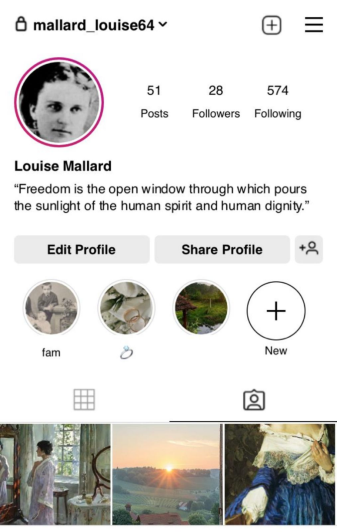
Fig. 3. An example of the completed task by a student
The other way to assess students’ understanding of the characters would be to ask them to create fictional «Google search» histories of one or several characters of the story, envisioning what would these characters search on the Internet. That is another example of a task aimed at demonstrating students’ comprehension of the figures of a literary work, as we could depict the things we envision to be matters the fictional characters care about through composing the mentioned «search bars».
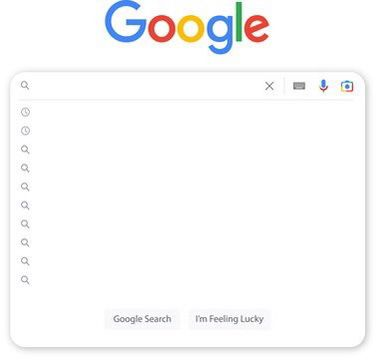
Fig. 4. «Google search» task
Taking forms of entertainment which are of interest to students into consideration, another way to ensure students’ engrossment in the lesson and in the story’s analysis, a teacher could always make use of various meme templates [4]. The popularity of meme culture makes it an ideal vessel for enhancing and modernising the classroom, which is especially pertinent with the association of memes with youth culture, the predominant age range within higher education [5]. Utilizing meme templates, students would be provided freedom to compose various jests on the literary work’s characters and the events around which the story is constructed. In comparison with the previous exercises described, this task is concerned not only with stories’ characters, but also their plots. Considering the wide amount of existing «meme» templates, there is a vast space for students’ possible jesting interpretations of fictional works.
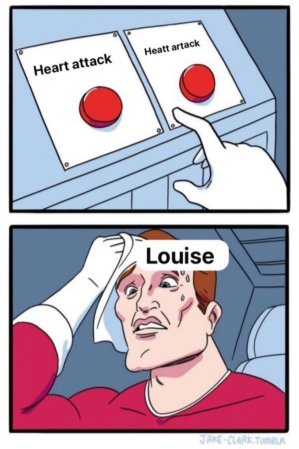
Fig. 5. An example of a meme on a story completed by a student
Analysing characters’ inner world also means correctly understanding their needs, wishes and things which are of interest for them. Examining students’ comprehension of that could be executed through the use of the task where the teacher needs to ask students to create a fictional store receipt of one or several characters from the literary work. The way the described exercise demonstrates students’ comprehension of characters wishes and needs is through the list of objects and products they consider to be the things a character would acquire for themselves. Needless to say, the students would also have to explain their choices. The task could also be conducted in the following way: students divide into small teams, each of them assumes the role of different characters from a story and after that they need to envision that they are making joint purchases from a store — this version of the exercise would promote teamwork.
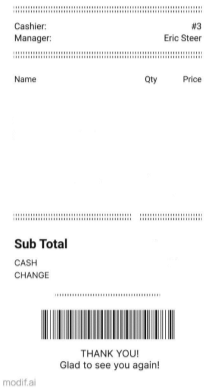
Fig. 6. An example of the store receipt template
Finishing a reading-based lesson includes composing final views of the story, events and characters. After analysis and completed tasks, the students may share their concluding judgements concerning the literary work studied. It could be executed with the utilization of such table:
Table 5
An example of a table for reflection
|
What I liked about the story |
What I found confusing in the story |
My favourite character or characters |
My controversial opinion on the story |
What I consider to be the morale of the story |
I agree with the ending / I would change the ending |
Completing the table, students should voice their answers verbally and interchange their views with each other, defending their opinions and providing some arguments for their vision of various matters, around which a story would be based. Articulating controversial viewpoints could potentially lead to debates, which would promote a considerable share of speaking.
Conclusion
As a conclusion, we envision a productive reading-based lesson as a lesson with an attention-stimulating warm-up activity, phased and gradual reading of a story, implementation of exercises, promoting creative and critical thinking, while also having a connection to modern life and tendencies, as well as reflection prompting sharing various viewpoints and substantial speaking.
Recommendations
We recommend making reading not passive, but rather active, providing students various reading comprehension questions or tasks after each part or fragment of a story they are reading, as it will help the teacher occupy the students without their loss of focus. Including creative exercises which require students’ active use of imagination results in students’ better immersion in the tasks, which in itself produces effective work.
References:
- Serda G. The importance of reading activities in reading comprehension // Disiplinlerarası Yen Araş Der. — 2022. — 2(1). — 29–34 p.
- Nurbianta N., Dahlia H. The Effectiveness of Jigsaw Method in Improving Students Reading Comprehension // ETERNAL (English Teaching Journal). — 2018. — 9(1). — 71 p.
- Fake Detail: https://fakedetail.com/fake-instagram-profile-generator. — 2025. — URL: https://fakedetail.com/fake-instagram-profile-generator (date of application: 01.06.2025).
- Imgflip LLC: https://imgflip.com/memetemplates. — 2025. — URL: https://imgflip.com/memetemplates (date of application: 01.06.2025).
- Tidy H., Bolton-King R. S., Croxton R. and others. Enhancing the student learning experience through memes // Science & Justice. — 2024. — 64(3). — 281 p.
[*] A product of the Meta company, which is recognized as an extremist organization in Russia.

